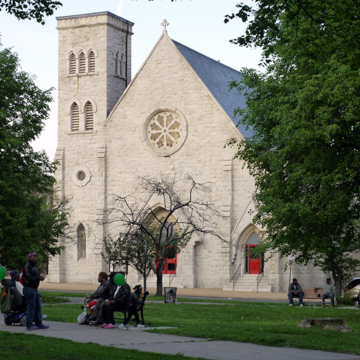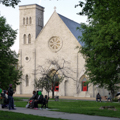Harlem Square Park and Lafayette Square Park are located in the Harlem Park neighborhood of West Baltimore. These parks’ history reveals the origin of the neighborhood as a country estate that would, in time, become a wealthy suburb and serve as a cultural center for West Baltimore’s African American community in the early twentieth century.
The Dutch merchant Adrian Valeck arrived in Baltimore at the end of the Revolutionary War and soon established his country estate named Haarlem. It was typical of large estates with an expansive garden of flowers and fruit trees imported from European nurseries. In the early nineteenth century, Dr. Thomas Edmondson purchased the estate and the gardens. As president of the Maryland Horticultural Society, Edmondson showed significant interest in sustaining the extensive gardens and the plant collection. A large portion of the estate was dedicated as Harlem Park in 1876.
Local real estate developer Joseph Cone took advantage of the new park by building a series of row houses. These Italianate buildings featured modern amenities such as gas lighting, hot water, and doorbells. German-speaking factory owners and shopkeepers from Baltimore’s growing middle-class purchased the new row houses. At nearly ten acres, Harlem Park featured flowerbeds designed in the shapes of diamonds, hearts, stars, and crosses.
In 1857, a group of local property owners donated land to the city to create Lafayette Square, about half the size of Harlem Park, which is located a few blocks to the southwest. Lafayette Square was located on a ridge in the city’s western reach with outstanding views of the nearby rivers, hills, and city landmarks. The Lafayette Square Company was created in 1865 to promote the development of the blocks surrounding the square. The new park was evidence of a larger emphasis in public parks as an integral part of the suburban life. However, with the onset of the Civil War, the Union Army occupied the city and built a hospital and camp on Lafayette Square. As soon as the troops departed in 1865, residents resumed their effort to improve the square. The city soon replanted trees and flowers and rebuilt winding walks through the park. By 1880, the square and its neighborhood included churches, mansions, and the new State Normal School (1875).
The history of Baltimore as a city is traced in that of the park and the square. In the early 1900s, residents in Harlem Park fought to exclude African Americans by imposing deed restrictions on local property owners and harassing Black citizens who tried to buy houses around the park. By the 1920s, however, the city’s growing Black middle-class successfully purchased many of the properties in the Harlem Park neighborhood. By the early 1930s, the neighborhood was largely African American, with doctors and lawyers occupying the beautiful houses fronting the squares, and working-class tenants occupying the boarding houses and smaller alley houses behind the stately row houses. Harlem Park became an integral part of a Black community that grew to include residences, churches, and businesses from North Avenue to Franklin Street and Eutaw Place to Fulton Avenue.
Harlem Park as a community shaped the activism and leadership of Baltimore’s Black community during the middle of the twentieth century. At the same time, local residents faced discrimination in employment, education, and housing, including the Federal Housing Administration policy of discouraging lending in Harlem Park and other Black neighborhoods through redlining. Many of the people who grew up in Harlem Park during this period spent their lives fighting discrimination and trying to improve conditions for the community and its residents.
Many of Baltimore’s older communities faced new challenges in the decades after World War II. Worries about overcrowded and deteriorating housing generated urban renewal programs that mixed social programs, demolition and rehabilitation projects, and a new school and housing over a twelve-block area. The city streets were also converted from two-way to one-way to accommodate the increase in car ownership and use. In 1961, the city demolished scores of residences south of Franklin Street for the development of the doomed East-West Expressway, which became known as the “Highway to Nowhere.” The 29 inner-block parks and the Harlem Park elementary and middle school building are legacies from this period of change.
In the late 1960s, despite growing opposition, the city demolished over a dozen blocks of houses and businesses between downtown to the site of the West Baltimore MARC Station. For decades, community activists have organized residents in Harlem Park and Lafayette Square to advocate for improved public safety, housing, and health. Unfortunately, the legacy of the displacement for the highway, urban renewal efforts, and decades of discrimination forced the neighborhood to continue to struggle with poverty and a large number of vacant properties.
In 2021, the nonprofit organization Harlem Park Community Development Corp., established to combat poverty and crime in the neighborhood, began developing a master plan with local design firm Ayers Saint Gross. Following community and stakeholder meetings, the final plan is anticipated in early 2022.
References
"Harlem Park." Baltimore Heritage. Accessed September 13, 2021. https://baltimoreheritage.org/.
Rodricks, Dan. "Promising Plan, Huge Challenge: A Harlem Park Renaissance in West Baltimore." The Baltimore Sun, July 9, 2021.





